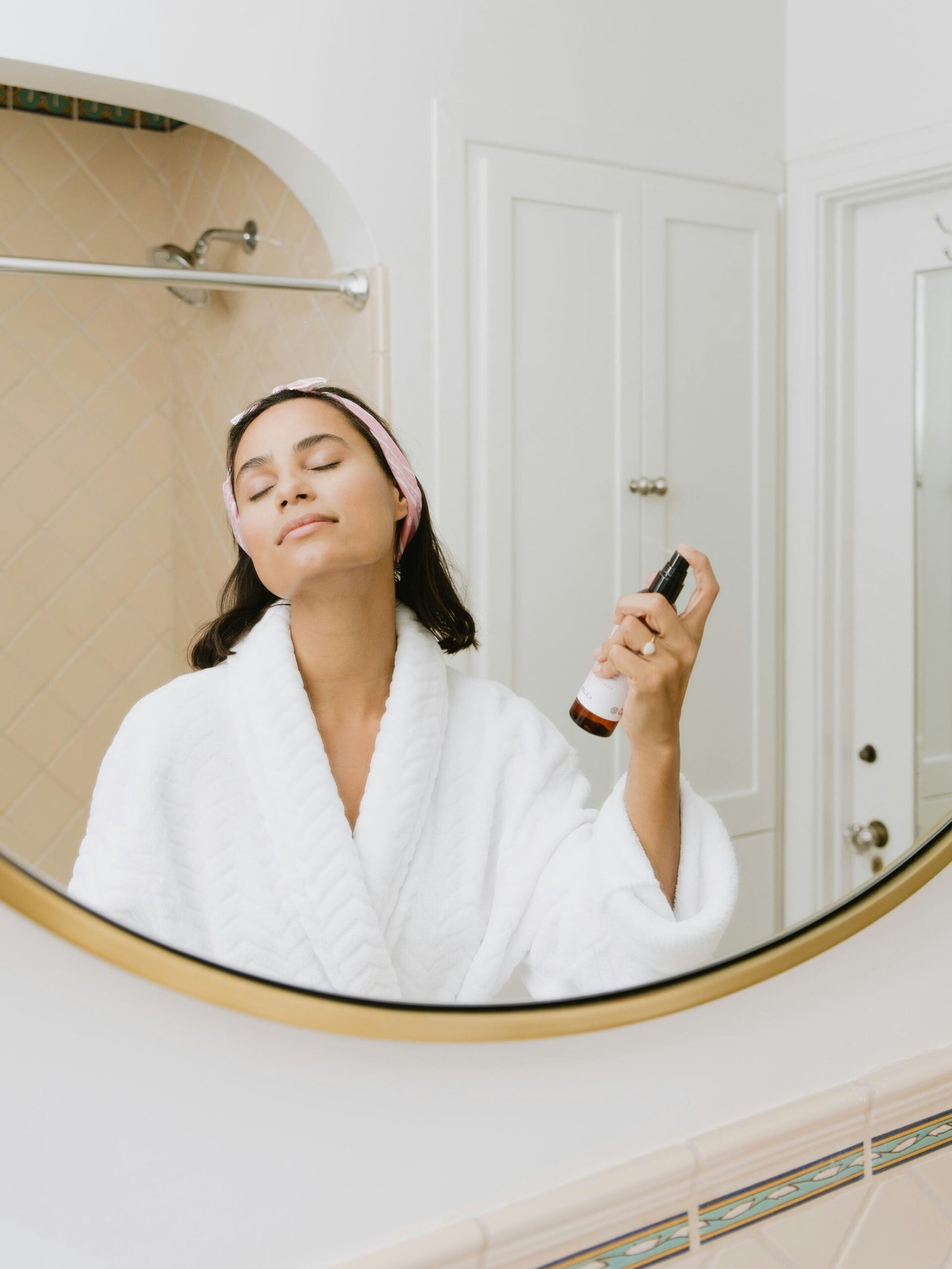Step 1: Start by wetting your face with lukewarm water. This will help to open up your pores and make it easier for the face wash to penetrate your skin. Avoid using hot water as it can strip your skin of its natural oils and cause dryness.
Step 2: Take a small amount of your chosen face wash and gently massage it onto your face using circular motions. Be sure to focus on areas that are prone to oiliness or congestion, such as the T-zone (forehead, nose, and chin).
Step 3: Rinse off the face wash thoroughly with lukewarm water. Make sure to remove all traces of the product to prevent any residue from clogging your pores. Pat your face dry with a clean towel, being careful not to rub or tug at your skin.
Step 4: Follow up with a toner to further cleanse and balance your skin. Toners help to remove any remaining impurities and restore your skin’s pH balance. Apply the toner to a cotton pad and gently swipe it across your face and neck.
Step 5: Finish off your skincare routine with a moisturizer appropriate for your skin type. This will help to hydrate and nourish your skin, leaving it feeling soft and supple. Massage the moisturizer onto your face and neck using upward strokes.
By incorporating these five simple steps into your daily skincare routine, you can achieve a clean and refreshed face. Remember to choose products that are suitable for your skin type and concerns. Consistency is key when it comes to skincare, so make sure to follow this routine morning and night for best results.
Additionally, it’s important to note that while face wash is an essential part of any skincare routine, it should not be the only step. It is recommended to also incorporate exfoliation, masks, and serums into your routine to address specific skin concerns and maintain optimal skin health.
Step 2: Consider Your Skin’s Sensitivity
When choosing a face wash, it’s crucial to consider your skin’s sensitivity. Some people have skin that is easily irritated by certain ingredients or harsh cleansers. If you have sensitive skin, look for a face wash that is labeled as gentle or specifically formulated for sensitive skin.
These types of face washes typically have a milder formula that is less likely to cause irritation or redness. They often contain soothing ingredients like aloe vera, chamomile, or oatmeal to calm and nourish the skin.
If you’re unsure about your skin’s sensitivity, it’s a good idea to do a patch test before using a new face wash. Apply a small amount of the product to a small area of your skin, such as the inside of your wrist, and wait for 24 hours to see if any adverse reactions occur.
Additionally, if you have any known allergies or sensitivities to certain ingredients, make sure to check the product’s ingredient list to avoid any potential irritants.
Step 2: Cleanse Your Face
Once you have chosen the right face wash, it’s time to cleanse your face. Start by wetting your face with lukewarm water. Take a small amount of the face wash in your hands and gently massage it onto your face in circular motions. Pay extra attention to areas with excess oil, dirt, or makeup.
Avoid using hot water, as it can strip your skin of its natural oils and cause dryness. Lukewarm water is the ideal temperature for cleansing as it helps to open up the pores and remove impurities.
As you massage the face wash onto your skin, be sure to use gentle and upward motions. This will not only help to remove dirt and oil but also stimulate blood circulation, giving your skin a healthy and radiant glow. Take your time and enjoy the process, allowing the face wash to work its magic.
Once you have thoroughly cleansed your face, rinse off the face wash with lukewarm water. Make sure to remove all traces of the product, as any residue left behind can clog your pores and lead to breakouts. Pat your face dry with a clean towel, being careful not to rub or tug at your skin.
After cleansing, your skin may feel refreshed and rejuvenated. However, it is important to follow up with the appropriate skincare routine to maintain the health and balance of your skin. Whether it’s applying toner, moisturizer, or serum, be sure to choose products that are suitable for your skin type and address any specific concerns you may have.
Remember, cleansing your face is not just about removing dirt and makeup. It is also a crucial step in preparing your skin for the absorption of other skincare products. By thoroughly cleansing your face, you are creating a clean canvas for the rest of your skincare routine to work effectively.
In addition to cleansing your face in the morning and evening, it is important to cleanse after sweating or being exposed to pollutants. This will help to prevent clogged pores and maintain the overall health of your skin.
So, make it a habit to cleanse your face regularly with a gentle face wash, and you will be rewarded with a clear, radiant, and healthy complexion.
Step 3: Rinse Thoroughly
After massaging the face wash onto your skin, rinse it off thoroughly with lukewarm water. Make sure to remove all traces of the product to prevent any residue from clogging your pores. Splashing your face with water multiple times can help ensure a thorough rinse.
It’s important to note that over-rinsing or scrubbing your face too vigorously can lead to irritation and dryness. Be gentle and take your time to ensure that your face is clean and refreshed.
Rinsing your face thoroughly is a crucial step in any skincare routine. When you rinse off the face wash, you not only remove the cleanser but also any dirt, oil, and impurities that may have accumulated on your skin throughout the day. Proper rinsing ensures that your skin is left clean and ready for the next steps in your skincare routine.
To achieve a thorough rinse, it is recommended to use lukewarm water. This temperature is gentle on the skin and helps to open up the pores, allowing for a deeper cleanse. Avoid using hot water as it can strip the skin of its natural oils, leaving it dry and dehydrated.
When rinsing your face, it’s important to pay attention to every area, including the hairline, jawline, and neck. These areas are often neglected but can accumulate dirt and oil just like the rest of your face. Use your fingertips to gently massage the water onto your skin, ensuring that every nook and cranny is reached.
While it’s tempting to scrub your face vigorously to ensure a thorough rinse, this can actually do more harm than good. Over-rinsing or scrubbing too harshly can disrupt the skin’s natural barrier and lead to irritation, redness, and dryness. Instead, be gentle and use light circular motions to massage the water onto your skin.
Once you feel that all traces of the face wash have been removed, continue rinsing for an additional 10-15 seconds to ensure a complete cleanse. This will help remove any residual product that may have been left behind.
After rinsing, pat your face dry with a clean towel. Avoid rubbing your skin as this can cause friction and irritation. Instead, gently press the towel against your skin to absorb the excess water. Your face is now clean and ready for the next steps in your skincare routine, such as applying toner, moisturizer, or any other treatments.
Step 4: Pat Dry and Tone
Once you have rinsed off the face wash, gently pat your face dry with a clean towel. Avoid rubbing your face, as this can cause friction and potentially irritate the skin. Instead, lightly press the towel against your skin to absorb any excess moisture.
After drying your face, it’s beneficial to use a toner to further cleanse and balance your skin. Toners help remove any remaining impurities and prepare your skin for the next steps in your skincare routine. Apply the toner to a cotton pad and gently swipe it across your face, focusing on areas that are prone to oiliness or congestion.
Step 5: Moisturize and Protect
The final step in your skincare routine is to moisturize and protect your skin. Using a moisturizer is essential for keeping your skin hydrated and nourished. Look for a moisturizer that suits your skin type and addresses any specific concerns you may have, such as dryness, aging, or sensitivity.
When choosing a moisturizer, consider the ingredients that will benefit your skin. For dry skin, look for moisturizers with hyaluronic acid or glycerin, which help to attract and retain moisture in the skin. If you have oily or acne-prone skin, opt for oil-free or non-comedogenic moisturizers to avoid clogging your pores.
Once you have chosen the right moisturizer, apply it to your face and neck using gentle upward motions. This not only helps to distribute the product evenly but also promotes blood circulation, giving your skin a healthy glow. Take your time while massaging the moisturizer into your skin, allowing it to fully absorb.
After moisturizing, it’s crucial to protect your skin from the harmful effects of the sun. Even on cloudy days, the sun’s rays can still penetrate through the clouds and cause damage to your skin. Therefore, it is essential to apply a broad-spectrum sunscreen with at least SPF 30 every morning.
When choosing a sunscreen, look for one that provides protection against both UVA and UVB rays. UVA rays can penetrate deep into the skin, causing premature aging and wrinkles, while UVB rays are responsible for sunburn. By using a broad-spectrum sunscreen, you can ensure that your skin is protected from both types of harmful rays.
Remember to apply sunscreen generously to all exposed areas of your body, including your face, neck, arms, and legs. Don’t forget about commonly overlooked areas such as the ears, back of the neck, and the tops of your feet. Reapply sunscreen every two hours, or more frequently if you are swimming or sweating.
In addition to sunscreen, consider wearing protective clothing, such as wide-brimmed hats, long sleeves, and sunglasses, to further shield your skin from the sun’s harmful rays. This is especially important during peak sun hours, typically between 10 am and 4 pm.
By following these steps and incorporating moisturizing and sun protection into your skincare routine, you can help maintain healthy, youthful-looking skin for years to come.


